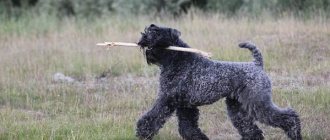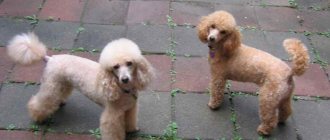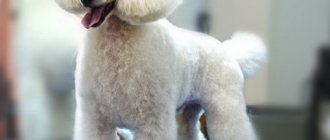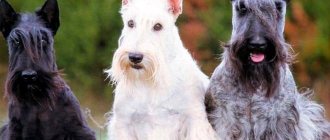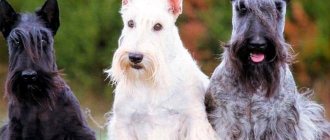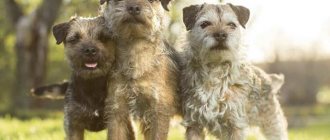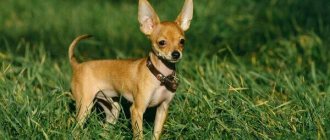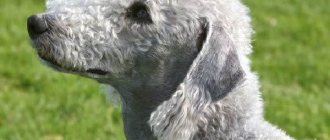History of the Kerry Blue Terrier breed
The Kerry Blue Terrier is a dog with an impressive, but not very clear history.
Experts still cannot establish the real ancestors of the animals and are limited to unconfirmed guesses regarding the degree of relationship of Kerry Blue Terriers with other breeds. For example, it is generally accepted that the first bearded dogs were born from the mating of Irish wolfhounds with black and tan English terriers, which were later replaced by Bedlingtons and wheaten terriers. At the same time, the Irish, greedy for legends and sensations, continue to believe that the ancestor of the breed was a blue Portuguese water dog, rescued from a sinking Spanish ship and picked up by farmers on the Emerald Isle. In the 19th century, owning a Kerry Blue Terrier was mandatory for Irish peasants. However, practical villagers did not want to keep animals “for their beautiful eyes,” so the four-legged pets were forced to do any feasible work – catching water rats, herding sheep flocks, guarding the owner’s property. Kerry Blue Terriers began to master breed exhibitions at the very end of the 19th century. Along the way, the dogs were involved in field tests, in which they achieved good results. As a result, it came to the point that a dog that did not show its success in catching and presenting an animal at an exhibition could not claim the championship title. But enterprising breeders got their bearings here too, and began to deliberately cultivate malice in their charges, for which the Kerry received the nickname “blue devils.”
In the 20s of the 20th century, Kerry Blue Terriers were standardized, and their owners began to unite in clubs. In 1922, the “Irish” were registered in England, and two years later the American Kennel Club followed the same procedure. The breed entered the USSR in the 60s. These were mainly individuals from Germany, which periodically appeared at all-Union exhibitions and even gave birth to offspring. As for the formation and development of Russian carry lines, the pioneer is usually called the Soviet breeding specialist A.I. Kozlovsky. On his initiative, the first collective kennel of the Irish Hippie breed in the USSR was created, from which several generations of healthy, impressive in appearance and mentally stable champions emerged.
PROMOTION ULTRASONIC TEETH CLEANING FOR ANIMALS (dog, cat, ferret, rabbit)
- Making an ornament (pattern) on wool 20 minutes (simple ornament) from 300 rub.
- Don't let the dogs loose - don't let the dogs get into a complete tangle and don't expect miracles from the master! The hairdresser has the right to refuse to give you a haircut.
- Depending on the condition of the coat, the presence of tangles, the animal’s behavior, aggressiveness, the cost of services may vary at the discretion of the specialist.
- Grooming cats in a salon
- Prices for hygiene services for dogs
- Ultrasonic teeth cleaning
- Fashionable haircuts for Yorkies
- Chinese crested haircut
Kerry Blue Terrier breed standard
Historically, Kerry Blue Terriers were typical farm dogs, kept not for their purity of blood, but for their help in household chores. Therefore, despite a century of exhibition breeding, peasant solidity and sometimes outright roughness of build still creep into the appearance of the breed. The abundant wavy coat helps hide anatomical imperfections, making the Kerry look dapper, elegant and extraordinary.
Sexual dimorphism for smoky “Irish” dogs is also a typical phenomenon - usually males have more powerful muscles and massive heads. The growth retardation in females is small: if the standard “boy” must be at least 45.5-49.5 cm at the withers, then for “girls” the ideal indicators are 44.5-48 cm. At exhibitions, strict requirements are imposed on the shape of the head and the coat structure of Kerry Blue Terriers. They are awarded the highest score. By the way, if you do not look closely at the animal, it may seem that its fur is curly. In fact, the excessive “poodleness” of a dog is a serious drawback. A true Kerry's hair is wavy and soft, but in no way curly.
Head
The skull is quite large, balanced, with a slight stop. Medium sized muzzle.
Teeth and jaws
The correct representative of the breed is distinguished by large, strong teeth and a scissor bite. Direct closure of the dentition is also allowed. The dog's jaws are strong and gripping. The mouth and the upper and lower gums should be black.
Nose
The harmoniously developed lobe is charcoal-black and has large, wide-open nostrils.
Eyes
The eyes are of medium size, normal shallow set, with a dark hazel or just dark iris. The look of the Kerry Blue Terrier is piercingly intelligent.
Ears
Neat, thin ears are held on the sides of the head, forming a fold in the middle part and falling forward. To ensure that the ear membrane takes the correct position, Kerry Blue Terrier puppies have it glued. Ear glueing begins at three months of age and ends when the animal is seven months old. In some individuals, the process of formation of cartilage tissue may be delayed. This is also normal, but it takes longer to glue such “stubborn” ears.
Neck
The necks of Kerry Blue Terriers are not too elongated, but not short either, with strong bases.
Frame
The purebred Kerry Blue Terrier is a stately pet, with prominent muscles and strong bones. An ideally horizontal, normal-length back is “strengthened” by a strong lower back. The animal's chest is characterized by normal width and pronounced depth with rounded ribs.
Limbs
The front legs of the dog in the stance are characterized by a straight position, as well as harmonious solidity of bones and muscles. The shoulder blades are oblique, with clear outlines and good fit to the sides. The hind legs are distinguished by a set under the body, large hips and hardy hocks. Kerry Blue Terriers have small paws, but with very developed dense pads. The animal moves easily, extending its front legs wide and making a powerful push with its hind legs. In this case, the head and tail of the running carry are carried as high as possible, and the back remains straight.
Tail
Representatives of the breed have a very thin, straight, well-set tail.
Wool
The hair is lush, moderately soft and wavy. The fur on the head and muzzle is especially developed.
Color
The coat of adult Kerry Blue Terriers is colored in all shades of blue and may also have black markings on the body. Moreover, all individuals are born black, gradually “lightening” by 1-1.5 years.
Disqualifying faults
Animals cannot be exhibited in show rings if they have pronounced defects in their appearance:
- overbite or underbite;
- “meat” colored gums;
- yellow or lightened iris tone;
- convex or saddle-shaped back;
- excessively narrow chest;
- elbows spaced from the body;
- dewclaws on the hind legs, even if they were once removed;
- a cow-like or stilted gait that is not typical for the breed;
- any coat color other than that specified by the standard;
- a tough, bristly dog.
Individuals with an unstable psyche, demonstrating aggression or behaving cowardly, do not pass the exhibition selection and are disqualified. In addition, fines are imposed on dogs that have to be helped to make the correct stance (raise their tail and head) during exposure.
Character of the Kerry Blue Terrier
When describing the character of Kerry Blue Terriers, it is customary to quote E. S. Montgomery, who argued that the breed is distinguished from the inhabitants of Ireland only by the fact that its representatives do not smoke pipes. In all other respects, the “sparkling” temperament of the animals completely copies the mentality of the inhabitants of the Emerald Isle. Playful, quick to start, loving daring fun and fights, Kerry Blue Terriers are the type of pets with whom your whole life is spent waiting for a surprise.
A true Kerry Blue Terrier is, first of all, a human-oriented creature. A puppy brought into the house quickly joins the family and learns to get along with each of its members, without appointing one person as a confidant. Children are pleasant companions and playmates for animals. By the way, unlike large breed dogs, Kerry dogs do not see children and teenagers as a lower caste, whose representatives should be treated condescendingly, but whose demands should not be responded to. Moreover, the natives of green Erin will willingly go with your heirs to the training ground and listen to the commands given by their young masters.
But Kerry Blue Terriers have a “C” level of understanding with their fellow tribesmen. Maybe because, seeing another dog, the “Irish” will not miss the opportunity to show off and demonstrate his own invincibility. Actually, 90% of conflicts with four-legged brothers begin with such provocations: the carry teases, the enemy makes a warning “R-rr!” – and a senseless fight flares up. There is an opinion that Kerry Blue Terriers are desperate cat haters, but clarification is required here: dogs only chase unfamiliar kitties. A purr who shares living space with a dog from an early age has the right to count on leniency.
As for the watchdog abilities of the breed, you can completely rely on them. True Kerry Blue Terriers do not suffer from idle talk and if they bark, it is for a reason. Of course, we are not talking about ill-mannered pets who use their voices out of boredom. Some carries are able to let a stranger into the house, but certainly not let them out of it. Usually the dog blocks the exits from the premises and carefully studies the behavior of the stranger. The reaction to any threatening gesture (waving a hand, trying to push away the tailed guard with a kick) should be harsh and immediate. By the way, the breed’s bites are painful and deep.
The Kerry Blue Terrier is incredibly jumpy and morbidly curious, so there are no forbidden places for him in the apartment, there are simply underexplored ones. At the same time, he is neat in everyday life and even despite the habit of gnawing something hard in his spare time, he does not suffer from destructive behavior and does not entertain himself by howling. In the absence of the owner, the pet is able to find a peaceful activity or take a sweet nap on the carpet until one of the family members appears in the house. And the Kerry Blue Terrier is a born humorist, easily transforming into a clown with a wild imagination and an inexhaustible supply of practical jokes. Be mentally prepared for funny pranks, strange tricks with surrounding objects and an amusing pantomime with the participation of a four-legged minion.
Education and training
Each Kerry Blue Terrier is a bright individual, so even an experienced dog handler cannot predict how easy it will be for a particular puppy to learn. However, almost all trainers note the breed's innate stubbornness when it comes to forcing them to practice. The reason for stubbornness lies in the fact that it is difficult for a carry to concentrate on things that seem obviously boring to him. In addition, this comrade constantly switches to external stimuli, such as a scurrying mouse or a fellow tribesman looming on the horizon. So you need to practice commands and sports skills with the breed quickly (a 10-minute exercise is the limit), persistently, but without unnecessary authoritarianism.
The limits of socialization and acquaintance of the pet with the surrounding reality during a walk should be adjusted by a leash (not a harness). Don't forget, the Irish love to provoke conflict situations with other dogs. Kerry Blue Terriers are raised using standard methods. First, the puppy is taught a uniform daily routine, the ability to respond to its own nickname and elements of etiquette. Attempts to attack a person, biting, growling and, in general, any demonstration of superiority must be suppressed. Carries are typical dominants, for whom it is enough to give in only once so that they have time to sit on the owner’s head.
The first commands in the life of every Kerry Blue Terrier are “Place!”, “No!” and “Come to me!” The easiest way to teach a puppy to go to his corner is to take him there after eating and, holding the animal on the bed with your hands, quietly but convincingly pronounce the command (“Place!”). You can read about how to correctly practice calling and other basic orders in books on training “Don’t growl at the dog” by K. Pryor, “The ideal dog does not walk the owner” by M. Rutter, “A dog without problems”, as well as “Dog obedience” » V. Gritsenko. Remember also that at the beginning of training, calling an animal for punishment or to take it away from a walk is a grave mistake. The Kerry Blue Terrier is not such a simpleton as to obey a command that limits its entertainment.
Punishments in a pet's life should take place when he is caught red-handed. There should be no retroactive “repressions” or beatings. They are also not punished for not understanding the requirements, being afraid of something, or for following commands too slowly. It is not recommended to catch the Kerry Blue Terrier in order to prevent him from doing what you do not like, and also to spank the dog with a leash. In the first case, the animal will perceive “catching up” as a fun game, not forgetting to deduct a hundred points from your authority. And in the second case, he will quickly understand that the strap contains a danger to his sides, and in the future he will not allow himself to be fastened.
Then there will be no hair in your house, and your pet will be healthy and beautiful!
French Bulldog
BOSTON TERRIER
8-15 kg
American bulldog
ALAPAH BULLDOG
Dog grooming: Mixed breeds, yard terriers.
— our masters will select a beautiful, stylish hairstyle for your favorite dog: Mixed breeds are small, medium and large, depending on the type of coat and haircut.
Grooming + combing 30 min.
Bathing + coat mask, nail trimming, ear cleaning, drying and blowing with a compressor.
Maintenance and care
Modern Kerry Blue Terriers are domestic animals in every sense. They are not demanding of space and are content with a modest bed somewhere in a corner, provided that the sun penetrates there and there is no draft. Both in puppyhood and in adulthood, the “Irish” loves to sharpen its teeth on objects. To do this, buy your pet special toys and update them periodically - rubber balls and squeakers cannot withstand the sharpness of dog teeth for long. From time to time, toys can be replaced with raw vegetables - carrots, cabbage leaves and other “goodies”.
It is important to monitor your puppy's legs and posture. During the first 6 months of life, Kerry Blue Terriers are not allowed to go up and down stairs on their own. You also can’t play “tug” with your dog - it’s easy to distort the animal’s bite during such entertainment, but it’s almost impossible to correct it. Adults need to be walked twice a day, spending at least two to three hours on promenades and sports exercises. Puppies are taken out to breathe and satisfy their toilet needs up to 5 times a day. Once the pet reaches 6 months of age, the number of excursions is reduced to three.
Hair cutting and hygiene
The Kerry Blue Terrier's coat is not harmed by frequent bathing, so in the warm season you can swim with your dog in open water at least every day. As for a full wash with shampoos and conditioners, it is acceptable to do it once every week or two. It is advisable to comb the Kerry more often. Breeders recommend brushing the puppies' coat daily to speed up the process of changing the puppy's hair. It is recommended to massage adult animals with a metal comb at least twice a week.
To maintain the glamorous appearance of a dog’s “coat,” the hair must be trimmed regularly—trimming is contraindicated for the breed. The cutting process is carried out in the following sequence:
- comb the wool, removing tangles, if any;
- wash the dog using shampoo for dry hair;
- allow the pet to dry naturally - the hair dryer is not used at all, or it is used, but the hair is not combed during the drying process;
- Comb completely dry hair against the grain.
Ideally, the Kerry Blue Terrier should adopt a show stance, which will make grooming easier, but in practice you can do without it. The main thing is to teach the dog to calmly respond to the procedure. Puppies get their first haircut at 3 months of age, and then as the hair grows back.
Important: Kerry Blue Terriers are not groomed on the eve of a show. The procedure must be carried out at least 3 weeks before entering the ring, so that the fur has time to grow and the transitions are leveled out.
They start cutting the dog from the head. First, the outer and inner parts of the ears are cut with a machine, and their edges are carefully processed with scissors. Thick bangs form above the eyes. The hair of the parietal zone is shortened either with a clipper or with scissors, leaving a neat wave of the dog’s hair no more than 1 cm long on the forehead. The areas of the temples, throat and areas on the sides of the eyes are cut very short.
The hair on the back is removed with scissors, lifting it against the growth with a metal comb. The optimal length of coat on this part of the body is from 2 to 5 cm. The same length is preferable on the sides and chest. The neck is also treated with scissors in the direction from the back of the head to the withers. In this case, it is important to make the transition as smooth as possible, since as the neck approaches the forearms, the length of the hair should increase.
The outer part of the tail continues the line of the back and is cut according to the same principle. But on the inner part of the dog it is necessary to shorten it as much as possible. Particular attention is given to the area under the tail. The fur around the anus should be very short. Otherwise, waste products will stick to the regrown curls.
For show dogs, the hair on the legs and lower part of the chest is not cut, only carefully combed, first downwards, then against the growth. Although for pets, especially young ones, trimming their limbs will not hurt. The beard and mustache, which are quite bushy in Kerry Blue Terriers, require special care. The hair in the corners of the mouth is usually removed, and too thick hair on the face is milled with scissors. The hairs between the toes and on the bottom of the paws are removed, forming a rounded outline. The hair on the outer part of the fingers is not removed.
Gross grooming mistakes:
- cutting hair under the eyes of a Kerry Blue Terrier;
- cutting of groins;
- leaving long hair on the head, sides, muzzle and belly.
Increased attention is necessary to the pet's visual organs. Like most breeds with “woolly” faces, the Kerry’s eyes are slightly leaky, which is especially noticeable in puppyhood, as well as in individuals with overgrown, unkempt bangs. Every day, the dog's eyelid folds and eyeballs should be wiped with a cloth soaked in warm water. It is also acceptable to use drops for excessive lacrimation, for example “Diamond Eyes”.
Once a week, you should check your Kerry Blue Terrier's ears and remove excess wax, if any. The procedure will require a clean cloth (no cotton swabs) and any hygienic lotion for dog ears. In addition, get ready to systematically pull out abundantly overgrown hair from the ear funnel, which reduces hearing acuity and provokes inflammation. This will have to be done manually, in several steps.
Hygiene of the Kerry beard and mustache is an essential part of caring for the breed. At home, it is better to tie the hair on your chin loosely with an elastic band. This will make it easier to wipe it after each feeding. Once every two weeks the dog gets a pedicure. After trimming the nails, it is also useful to sand the plate with a nail file.
The Kerry Blue Terrier's teeth should be brushed with a brush and veterinary toothpaste. But if the animal is not accustomed to such a procedure, the problem will have to be solved in alternative ways. For example, adding tomato juice to your pet’s food or chewing treats from a pet store.
Feeding
It is better to feed the Kerry Blue Terrier according to a schedule, organizing the food so that the dog is in good condition, but does not get fat. Natural products that are best suited for the breed include:
- raw lean meat - beef, horse meat, goat meat, lamb;
- raw or boneless fish poached in oil - hake, navaga, cod, but not more than 2 times a week;
- low-fat kefir, cottage cheese, occasionally cheese;
- once a week a chicken egg - boiled white and raw yolk;
- vegetables and fruits, except legumes;
- cereal porridges – buckwheat, rice;
- young greens - nettle, dandelion leaves, lettuce, parsley;
- vitamin supplements and delicacies - seaweed, sauerkraut, dried fruits.
It is forbidden to treat your puppy to tubular and bird bones, but sometimes you can allow a little pampering in the form of lamb ribs. Meat for Kerry Blue Terriers is always chopped into pieces, but never minced. They provide cold cuts for breakfast and dinner.
In addition, it is important to remember that up to a year, Kerry Blue Terriers require mineral supplements and ready-made vitamin complexes. They do not buy dietary supplements only for individuals who have been eating dry food (of course, high-quality food) from the first months of life. Frequency of feeding the Kerry Blue Terrier: up to 4 months - four times a day, from 4 months to six months - three times a day, from 6 months onwards - two meals a day.
Price list | Dog grooming
Pet salon "Balyti" professional hairdressing (grooming) services for pets.
“please warn the handlers in advance about the dog’s previous surgeries, injuries and estrus, and about its anxious character (fearfulness, aggressiveness)”
Discount for puppies up to 10 months - please call for details.
YO RKSHIRE TERRIER, Biewer York (Yorkshire, mini, standard) grooming master professional, more than 2 years of experience.
sports/with skirt and paws
Yorkie puppy, first hygienic haircut according to breed standard, up to 6 months - up to 30% discount on hygienic haircut only on weekdays - call for details*
(set: hair trimming on ears, butt and tummy, muzzle, claw trimming, ear cleaning + plucking fur inside the ear + bathing, hair mask as a gift, blow-dry)
4. Bichon Frize - master breeder
Korean style, for the exhibition, complex haircuts. Groomer is a Bichon Frize breeder.
Petit Brabançon (Petit Brabançon, Brabant or Smooth-haired Griffon - express shedding
Schipperke - complex + 30 minutes express molt.
Your presence in the grooming room when grooming your dog is by appointment only.
Also, when you are near a dog, you take full responsibility for the dog.
When registering a dog, it is mandatory to warn the administrator about the desire to be present with the dog.
Presence is paid - 1500 rubles.
Master class 6000 rub.
Since January 1, 2015, the Baluti pet salon has been holding a promotion: “Switching to trimming.” The promotion is designed for dogs of trimmable breeds that have previously had their hair clipped. The advantages of trimming are obvious:
Express molt
2600
"Complex Lux". The procedure includes: express shedding for 40 minutes + wash, + dry + blowing out fur with a compressor, + ear cleaning (plucking), + nail trimming, + perfume -
Wire -haired dachshund
Health and disease of Kerry Blue Terriers
The average life expectancy of the breed is 13 years. However, with good care, many individuals are able to overcome this age level. There are also cases where the “Irish” ended their life at the age of 18. Kerry is less susceptible to hereditary diseases than most purebred tribesmen. For example, joint dysplasia, which affects many large and medium-sized dogs, occurs in a very small number of Kerry Blue Terriers. But the “Irish” periodically experience joint subluxation, which can be caused both by the consequences of injury and genetically.
Hypothyroidism, as well as von Willebrand's and Addison's diseases, also occur among people from the Emerald Isle, but not as often as one might expect. The real problem for the breed is progressive nervous abiotrophy. The disease has no cure, it is inherited, but it is not yet possible to determine its carrier. The disease appears in 2-6 month old puppies, and by the age of one year the animals are completely immobilized.
Dry keratoconjunctivitis is also detected in Kerry Blue Terriers, as well as a tendency of the integument to form epidermal cysts. In the first case, the disease can become chronic, and in the second, growths on the skin often become infected. Not exactly a disease, but quite an unpleasant thing - calluses on the pads and between the toes. They form in Irish dogs more often than in other dogs, causing lameness.
Of the eye pathologies, Kerry Blue Terriers suffered from entropion and juvenile cataracts. Inflammation of the middle ear is another common disease of the breed. Most often, it affects individuals whose owners are too lazy to systematically clean their pets’ ears and pluck out overgrown hair from them.
How to choose a puppy
Do not forget that all representatives of the breed are born with a black coat color. If you are afraid of being deceived by the seller, get ready to buy one and a half year old animals - by this age Kerry Blue Terriers acquire the traditional blue color.
- Choose country kennels where dogs lead a relatively free lifestyle, and are not locked within four walls by ruthless breeder sellers.
- Find out what kind of food the breeder gives to his charges. If this is a cheap “drying”, do not expect to purchase a healthy animal from such a “thrifty” specialist.
- Assess the overall grooming of the litter. Are the puppies thin, how clean are their fur and areas under their tails, are there any fleas on their bodies.
- Even if the Kerry Blue Terrier is not purchased for exhibition, check out the pedigree of its parents. This will allow you to better understand the potential of your future pet.
- It is not always possible to diagnose a predisposition to hereditary diseases in advance. But if the breeder reports that his sires have been tested for at least genetic joint dysplasia, this is a big plus.
Schnauzers:
THE COLLUNTS ARE NOT INCLUDED IN THE COMPLEX!
Hairless Cocker Spaniel.
Dirty paws and belly or a dog in mats.
THE COLLUNTS ARE NOT INCLUDED IN THE COMPLEX!
Express and super shedding RUB 1,300. hour
Full plush dog grooming with scissors - price negotiable
Cutting tangles /fur coats is discussed with the master
chalk 1000 - small 2000 - medium 4000 - large large 6000
5000
SAMOYED - CUT THE BODY WITH SCISSORS.
+ hygienic haircut (cutting the groin area, paw pads) + bathing, coat mask + combing for 30 minutes while drying, nails and ear cleaning.

